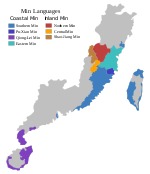Ningde dialect
| Ningde | |
|---|---|
| 寧德話 | |
| Native to | Ningde, Fujian |
Sino-Tibetan
| |
Early forms | |
| Language codes | |
| ISO 639-3 | – |
| Glottolog | None |
| Linguasphere | 79-AAA-icb |
The Ningde dialect (Eastern Min: 寧德話) is a dialect of Eastern Min Chinese spoken in urban areas of Ningde, China, which is a prefecture-level city in the northeastern coast of Fujian province.
Phonology
[edit]The Ningde dialect has 15 initials, 78 rimes and 7 tones.
Initials
[edit]p, pʰ, m, t, tʰ, n, l, ts, tsʰ, s, k, kʰ, ŋ, x, ʔ
Rimes
[edit]10 monophthongs: a, ɛ, œ, ø, ɔ, o, i, u, y
18 compound vowels: ai, ei, ɔi, oi, øy, au, ɛu, eu, ou, ia, ie, iu, iɐu, ua, uo, ui, uai, uoi
15 nasal rimes: aŋ, ɛŋ, eŋ, œŋ, øŋ, ɔŋ, oŋ, iŋ, uŋ, yŋ, iaŋ, iɛŋ, uaŋ, uoŋ, yøŋ
26 checked rimes: aʔ, ɛʔ, œʔ, øʔ, ɔʔ, iʔ, iaʔ, iɛʔ, uaʔ, uoʔ, yøʔ, ak̚, ɛk̚, ek̚, œk̚, øk̚, ɔk̚, ok̚, ik̚, uk̚, yk̚, iak̚, iɛk̚, uak̚, uok̚, yøk̚
These 6 nasal rimes tend to merge into nasal rimes ending with coda -ŋ, and will disappear in future: am, ɛm, em, im, iɛm, ɔn
These 5 checked rimes tend to merge into nasal rimes ending with coda -k̚, and will disappear in future: ap̚, ɛp̚, ep̚, ip̚, iɛp̚
Tones
[edit]| No. | 1 | 2 | 3 | 4 | 5 | 6 | 7 |
|---|---|---|---|---|---|---|---|
| Tone name | dark level 陰平 |
light level 陽平 |
rising 上聲 |
dark departing 陰去 |
light departing 陽去 |
dark entering 陰入 |
light entering 陽入 |
| Tone contour | ˦ (44) | ˨ (22) | ˦˨ (42) | ˧˥ (35) | ˧˧˨ (332) | ˨ (2) | ˥ (5) |
Initial assimilation
[edit]The two-syllable initial assimilation rules are shown in the table below:
| Coda of the Former Syllable | Initial Assimilation |
|---|---|
| Null coda | The initial of the latter syllable may change: |
| Nasal coda | The initial of the latter syllable may change:
|
| checked coda | The former syllable lost its checked coda at first; then, the initial assimilation of latter syllable follow the law above. |
| checked coda /-p̚/ | The Initial of latter syllable change to /p/ while the former syllable lost its checked coda /-p̚/ |
Tone sandhi
[edit]The Ningde dialect has extremely extensive tone sandhi rules: in an utterance, only the last syllable pronounced is not affected by the rules. The two-syllable tonal sandhi rules are shown in the table below (the columns give the first syllable's original citation tone, while the rows give the citation tone of the second syllable):
| dark level 44 |
light level 22 |
rising 42 |
dark departing 35 |
light departing 332 |
dark entering 2 |
light entering 5 | |
| dark level 44 |
44 | 21 | 44 | 21 | 44 | 21 | |
| light level 22 |
remain unchanged | ||||||
| rising 42 |
55 | ||||||
| dark departing 35 |
55 | ||||||
| light departing 332 |
44 | 21 | 44 | 21 | 44 | 21 | |
| dark entering 2 |
55 | ||||||
| light entering 5 |
44 | 21 | 44 | 21 | 44 | 21 | |
Notes
[edit]References
[edit]- ^ Mei, Tsu-lin (1970), "Tones and prosody in Middle Chinese and the origin of the rising tone", Harvard Journal of Asiatic Studies, 30: 86–110, doi:10.2307/2718766, JSTOR 2718766
- ^ Pulleyblank, Edwin G. (1984), Middle Chinese: A study in Historical Phonology, Vancouver: University of British Columbia Press, p. 3, ISBN 978-0-7748-0192-8
- ^ Hammarström, Harald; Forkel, Robert; Haspelmath, Martin; Bank, Sebastian (2023-07-10). "Glottolog 4.8 - Min". Glottolog. Leipzig: Max Planck Institute for Evolutionary Anthropology. doi:10.5281/zenodo.7398962. Archived from the original on 2023-10-13. Retrieved 2023-10-13.
- Compilation Commission of Chorography of Ningde City 宁德市地方志编纂委员会 (1995). Ning de shi zhi 宁德市志 ["Chorography of Ningde City"]. Vol. 31. Beijing: Zhonghua Book Company. ISBN 7-101-01543-3.

